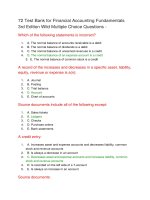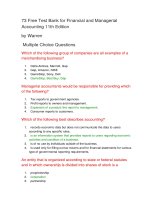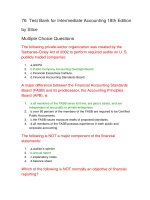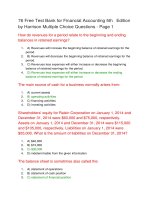76 test bank for intermediate accounting 18th edition đề trắc nghiệm có đáp án
Bạn đang xem bản rút gọn của tài liệu. Xem và tải ngay bản đầy đủ của tài liệu tại đây (45.96 KB, 14 trang )
76 Test Bank for Intermediate Accounting 18th Edition
by Stice
Multiple Choice Questions
The following private-sector organization was created by the
Sarbanes-Oxley Act of 2002 to perform required audits on U. S.
publicly traded companies:
1.
2.
3.
4.
a.AICPA
b.Public Company Accounting Oversight Board
c.Financial Executives Institute.
d.Financial Accounting Standards Board.
A major difference between the Financial Accounting Standards
Board (FASB) and its predecessor, the Accounting Principles
Board (APB), is
1.
a.all members of the FASB serve full time, are paid a salary, and are
independent of any public or private enterprises.
2. b.over 50 percent of the members of the FASB are required to be Certified
Public Accountants.
3. c.the FASB issues exposure drafts of proposed standards.
4. d.all members of the FASB possess experience in both public and
corporate accounting.
The following is NOT a major component of the financial
statements:
1.
2.
3.
4.
a.auditor’s opinion
b.annual report
c.explanatory notes
d.balance sheet
Which of the following is NOT normally an objective of financial
reporting?
1.
a.To provide information about an entity's assets and claims against those
assets
2. b.To provide information that is useful in assessing an entity's sources and
uses of cash
3. c.To provide information that is useful in lending and investing decisions
4. d.To provide information about an entity's liquidation value
Primary responsibility for GAAP and public reporting currently
rests with the
1.
a.SEC.
2.
3.
4.
b.FASB.
c.Congress.
d.AICPA.
The primary current source of generally accepted accounting
principles for governmental operations is the
1.
2.
3.
4.
a.Financial Accounting Standards Board.
b.Securities and Exchange Commission.
c.Governmental Accounting Standards Board.
d.Government Accounting Office.
Which of the following is an internal user of a company's financial
information?
1.
2.
3.
4.
a.Board of directors
b.Stockholders in the company
c.Holders of the company's bonds
d.Creditors with long-term contracts with the company
The following are users of accounting information:
1.
2.
3.
4.
a.stakeholders
b.creditors
c.investors
d.all of the above
The International Accounting Standards Board was formed to
1.
2.
3.
4.
a.enforce FASB standards in foreign countries.
b.develop worldwide accepted accounting standards.
c.establish accounting standards for U.S. multinational companies.
d.develop accounting standards for countries that do not have their own
standard-setting bodies.
Proper application of accounting principles is most dependent
upon the
1.
2.
3.
4.
a.existence of specific guidelines.
b.oversight of regulatory bodies.
c.external audit function.
d.professional judgment of the accountant.
Which of the following is a characteristic of the Financial
Accounting Standards Board?
1.
2.
3.
4.
a.The FASB is composed of five members.
b.FASB members must come from CPA firms.
c.FASB members are part-time.
d.FASB members may retain their positions with previous employers.
The area of accounting that emphasizes developing accounting
information for use within a company is known as __________
accounting.
1.
2.
3.
4.
a.management
b.forensic
c.audit
d.financial
As independent (or external) auditors, CPAs are primarily
responsible for
1.
2.
3.
4.
a.preparing financial statements in conformity with GAAP.
b.certifying the accuracy of financial statements.
c.expressing an opinion as to the fairness of financial statements.
d.filing financial statements with the SEC.
__________ accounting focuses on the development and
communication of financial information for external users.
1.
2.
3.
4.
a.management.
b.forensic
c.audit
d.financial
When the FASB deliberates about an accounting standard, firms
whose financial statements would be affected by that standard
1.
2.
a.are legally barred from lobbying the FASB.
b.are not allowed to lobby the FASB if the standard would have a negative
impact on their financial statements.
3. c.are not allowed to lobby the FASB if the standard would have a positive
impact on their financial statements.
4. d.are free to lobby for or against the standard.
Operations of the FASB are overseen by the:
1.
2.
3.
4.
a.operations of the AICPA.
b.Financial Accounting Foundation
c.AAA.
d.financial reporting arm of the SEC.
Generally accepted accounting principles
1.
2.
a.are accounting adaptations based on the laws of economic science.
b.derive their credibility and authority from legal rulings and court
precedents.
3. c.derive their credibility and authority from the federal government through
the financial reporting section of the SEC.
4.
d.derive their credibility and authority from general recognition and
acceptance by the accounting profession.
How many board members serve on the FASB?
1.
2.
3.
4.
a.5
b.7
c.14
d.20
The overall objective of financial reporting is to provide
information
1.
2.
3.
4.
a.that is useful for decision making.
b.about an enterprise's assets, liabilities, and owners' equity.
c.about an enterprise's financial performance during a period.
d.that allows owners to assess management's performance.
The SEC was given the power to establish accounting principles
including setting requirements for details shown on financial
statements by the:
1.
2.
3.
4.
a.FASB
b.AICPA
c.Congress
d.AAA
The primary purpose of the Securities and Exchange Commission
is to
1.
2.
3.
4.
a.regulate the issuance and trading of securities.
b.issue accounting and auditing regulations for publicly held companies.
c.prevent the trading of speculative securities.
d.enforce generally accepted accounting principles.
The responsibility to review the work of the accountants and issue
opinions as to the fairness of the financial statements rests with
1.
2.
3.
4.
a.the external auditor.
b.the board of directors.
c.the internal auditors.
d.management.
The staff interpretations statements issued by the SEC are
called:
1.
2.
3.
4.
a.Staff Accounting Research Bulletins.
b.Statements on Accounting Principles.
c.Financial Accounting Standards.
d.Staff Accounting Bulletins
The members of the __________ are appointed by the Financial
Accounting Foundation.
1.
2.
3.
4.
a.American Accounting Association.
b.Financial Accounting Standards Board
c.Securities and Exchange Commission.
d.American Institute of Certified Public Accountants.
The Governmental Accounting Standards Board
1.
a.was incorporated into the Financial Accounting Standards Board when
the FASB was created.
2. b.addresses financial reporting issues of U.S. government treaties and
treasury rulings.
3. c.addresses the financial reporting issues related to state and local
governments.
4. d.addresses the governmental reporting activities of the SEC.
Interested parties receive information about a company’s past
performance from:
1.
2.
3.
4.
a.CEO’s
b.the SEC
c.financial reporting
d.financial news
Accounting standards help accountants meet the information
demands of interested parties by providing:
1.
2.
3.
4.
a.legislation introduction pertaining to financial reporting
b.limits and guidance for financial reporting
c.improved operating plans to the Board
d.reports to the Media
The responsibility of the Emerging Issues Task Force (EITF) is to
1.
a.issue statements which reflect a consensus of the EITF on how to
account for new financial reporting issues where guidance is needed quickly.
2. b.do research on financial reporting issues that are being addressed by the
AICPA.
3. c.respond to groups lobbying the FASB on issues that affect a particular
industry.
4. d.develop concept statements the AICPA can use as a frame of reference
to solve future problems.
Form 10-K is submitted to the
1.
2.
3.
4.
a.FASB.
b.GASB.
c.IRS.
d.SEC.
The __________ of a firm is primarily responsible for the
preparation of financial statements in accordance with GAAP.
1.
2.
3.
4.
a.the internal auditors.
b.management.
c.the external auditors.
d.the board of directors.
Which of the following items is not a modifying convention?
1.
2.
3.
4.
a.Matching
b.Materiality
c.Industry practices
d.Conservatism
In 1973, the following private-sector body was organized to set
accounting standards in the United States:
1.
2.
3.
4.
a.the Financial Accounting Foundation.
b.the Securities and Exchange Commission.
c.the FASB
d.the Accounting Principles Board
The normal order followed by the FASB in publishing its
standards is
1.
2.
3.
4.
a.statement, discussion memorandum, opinion.
b.discussion memorandum, interpretation, exposure draft, statement.
c.exposure draft, discussion memorandum, statement.
d.discussion memorandum, exposure draft, statement.
The primary current source of generally accepted accounting
principles for nongovernmental operations is the
1.
2.
3.
4.
a.American Institute of Certified Public Accountants.
b.Securities and Exchange Commission.
c.Financial Accounting Standards Board.
d.Governmental Accounting Standards Board.
The process of establishing financial accounting standards is
1.
a.a democratic process in that a majority of practicing accountants must
agree with a standard before it becomes implemented.
2. b.a legislative process based on rules promulgated by government
agencies.
3. c.based solely on economic analysis of the effects each standard will have
if it is implemented.
4. d.a social process which incorporates political actions of various interested
user groups as well as professional research and logic.
Documents issued by the FASB include all of the following
except
1.
2.
3.
4.
a.Statements of Financial Accounting Standards.
b.Interpretations of Statements of Financial Accounting Standards.
c.Statements of Financial Accounting Concepts.
d.Financial Reporting Releases.
Once the FASB has established an accounting standard, the
1.
2.
3.
a.standard is continually reviewed to see if modification is necessary.
b.standard is not reviewed unless the SEC makes a complaint.
c.task of reviewing the standard to see if modification is necessary is given
to the AICPA.
4. d.principle of consistency requires that no revisions ever be made to the
standard.
76 Free Test Bank for Intermediate Accounting 18th
Edition by Stice Multiple Choice Questions - Page 2
Large business enterprises employ financial accountants who are
primarily concerned with__________ financial reporting.
1.
2.
3.
4.
a.corporate tax
b.management
c.external
d.international
When financial reports from two different companies have been
prepared and presented in a similar manner, the information
exhibits the characteristic of
1.
2.
3.
4.
a.relevance.
b.reliability.
c.comparability.
d.consistency.
For which of the following reporting issues has the FASB adopted
substantially the same approach as the IASB?
1.
2.
3.
4.
a.Segment reporting
b.Earnings per share
c.Statement of cash flows
d.Pension plans
The journal Accounting Horizons is published by which of the
following organizations?
1.
a.American Institute of Certified Public Accountants (AICPA)
2.
3.
4.
b.American Accounting Association (AAA)
c.Securities and Exchange Commission (SEC)
d.Financial Accounting Standards Board (FASB)
Which of the following elements of financial statements is not a
component of comprehensive income?
1.
2.
3.
4.
a.Revenues
b.Expenses
c.Losses
d.Distributions to owners
Which of the following measurement attributes is not currently
used in practice?
1.
2.
3.
4.
a.Present value
b.Net realizable value
c.Current replacement cost
d.Inflation-adjusted cost
Accountants prepare financial statements at arbitrary points in
time during a company's lifetime in accordance with the
accounting concept of
1.
2.
3.
4.
a.matching.
b.comparability.
c.accounting periods.
d.materiality.
When a large number of individuals, using the same
measurement method, demonstrate that a high degree of
consensus can be secured among independent measurers, then
the result exhibits the characteristic of
1.
2.
3.
4.
a.verifiability.
b.neutrality.
c.relevance.
d.reliability.
Financial information exhibits the characteristic of consistency
when
1.
a.accounting procedures are adopted which smooth net income and make
results consistent between years.
2. b.extraordinary gains and losses are shown separately on the income
statement.
3. c.accounting entities give similar events the same accounting treatment
each period.
4. d.expenditures are reported as expenses and netted against revenue in the
period in which they are paid.
The following is NOT one of the fundamental criteria for
recognition?
1.
2.
3.
4.
a.Timeliness
b.Measurability
c.Relevance
d.Reliability
Internal users are provided information by the following branch of
accounting:
1.
2.
3.
4.
a.auditing.
b.managerial accounting.
c.financial accounting.
d.income tax accounting.
Recording the purchase price of a paper shredder (with an
estimated useful life of 10 years) as an expense of the current
period is justified by the
1.
2.
3.
4.
a.going-concern assumption.
b.materiality constraint.
c.matching principle.
d.comparability principle.
Important constraints underlying the qualitative characteristics of
accounting information are
1.
2.
3.
4.
a.historical cost and going concern.
b.materiality, conservatism, and cost-effectiveness.
c.consistency, comparability, and conservatism.
d.verifiability, neutrality, and representational faithfulness.
The primary measurement basis currently used to value assets in
external financial statements of an enterprise is the
1.
a.current market price if the assets currently held by an enterprise were
sold on the open market.
2. b.current market price if the assets held by an enterprise were purchased
on the open market.
3. c.present value of the cash flows the assets are expected to generate over
their remaining useful lives.
4. d.market price of the assets held by an enterprise at the date the assets
were acquired (although some assets may be valued at their current selling
price or net realizable value).
According to the FASB's conceptual framework, the process of
reporting an item in the financial statements of an entity is
1.
a.realization.
2.
3.
4.
b.recognition.
c.matching.
d.allocation.
Which of the following is not included in the highest authoritative
level of GAAP?
1.
2.
3.
4.
a.FASB Statements
b.AICPA Statements of Position
c.FASB Staff Positions
d.Accounting Principles Board (APB) Opinions
What accounting concept justifies the use of accruals and
deferrals?
1.
2.
3.
4.
a.Going-concern assumption
b.Corporate form of organization
c.Consistency characteristic
d.Arm's-length transactions
Which of the following statements concerning the objectives of
financial reporting is correct?
1.
2.
a.The objectives are intended to be specific in nature.
b.The objectives are directed primarily toward the needs of internal users of
accounting information.
3. c.The objectives were the end result of the FASB's conceptual framework
project.
4. d.The objectives encompass not only financial statement disclosures, but
other information as well.
An item would be considered material and therefore would be
disclosed in the financial statements if the
1.
2.
3.
4.
a.expected benefits of disclosure exceed the additional costs.
b.impact on earnings is greater than 3 percent.
c.FASB definition of materiality is met.
d.omission of misstatement of the amount would make a difference to the
users.
The United States Securities and Exchange Commission
1.
a.has recognized IASB standards as an acceptable alternative to U.S.
GAAP.
2. b.requires foreign companies listing their shares on U.S. stock exchanges
to restate their financial statements to U.S. GAAP.
3. c.has barred foreign companies from listing their shares on U.S. stock
exchanges.
4. d.has no jurisdiction in the United States over foreign companies listing
their shares on U.S. stock exchanges.
The assumed continuation of a business entity in the absence of
evidence to the contrary is an example of the accounting concept
of
1.
2.
3.
4.
a.accrual.
b.consistency.
c.comparability.
d.going concern.
The branch of accounting that is concerned with providing
information to present and potential creditors of an enterprise is
1.
2.
3.
4.
a.auditing.
b.managerial accounting.
c.financial accounting.
d.income tax accounting.
In an effort to improve the conceptual framework, the FASB, in
conjunction with the IASB has been moving towards more
__________ standards.
1.
2.
3.
4.
a.rules approach
b.principles approach
c.broad approach
d.international approach
Financial statements issued for the use of parties external to the
enterprise are the primary responsibility of the
1.
2.
3.
4.
a.management of the enterprise.
b.stockholders of the enterprise.
c.independent auditors of the enterprise.
d.creditors of the enterprise.
Enron’s problem with related-party transactions breached the
assumption of:
1.
2.
3.
4.
a.going concerns
b.arm’s-length transactions
c.freedom of enterprise
d.market stability
Historical cost has been the valuation basis most commonly used
in accounting because of its
1.
2.
3.
4.
a.timelessness.
b.conservatism.
c.reliability.
d.accuracy.
Accounting for inventories by applying the lower-of-cost-or-market
is an example of the application of
1.
2.
3.
4.
a.conservatism.
b.comparability.
c.consistency.
d.materiality.
Which of the following is NOT a purpose of the conceptual
framework of accounting?
1.
2.
a.To provide definitions of key terms and fundamental concepts
b.To provide specific guidelines for resolving situations not covered by
existing accounting standards
3. c.To assist accountants and others in selecting among alternative
accounting and reporting methods
4. d.To assist the FASB in the standard-setting process
The financial statements that are prepared for the business are
separate and distinct from the owners according to the
1.
2.
3.
4.
a.going-concern assumption.
b.matching principle.
c.economic entity assumption.
d.full disclosure principle.
The accrual basis of accounting is based primarily on
1.
2.
3.
4.
a.conservatism and revenue realization.
b.conservatism and matching.
c.consistency and matching.
d.revenue realization and matching.
The secondary qualitative characteristics of accounting
information are
1.
2.
3.
4.
a.relevance and reliability.
b.comparability and consistency.
c.understandability and decision usefulness.
d.materiality and conservatism.
Financial disclosure statements are strictest in
1.
2.
3.
4.
a.the United Kingdom.
b.Germany.
c.the United States.
d.France.
The following is a qualitative characteristic of accounting
information:
1.
2.
3.
4.
a.timeliness
b.feedback value
c.neutrality
d.decision usefulness.
A conceptual framework of accounting should
1.
a.lead to uniformity of financial statements among companies within the
same industry.
2. b.eliminate alternative accounting principles and methods.
3. c.guide the AICPA in developing generally accepted auditing standards.
4. d.define the basic objectives, terms, and concepts of accounting.
Which of the following is true about international accounting
standards?
1.
a.Significant differences exist between U.S. GAAP and GAAP of other
countries.
2. b.Few differences exist between U.S. GAAP and GAAP of other countries.
3. c.The IASB is the standards-setting body of France.
4. d.It is unlikely that the differences between U.S. GAAP and GAAP of other
countries will diminish over time.
Which of the following is NOT an implication of the going-concern
assumption?
1.
2.
3.
a.The historical cost principle is credible.
b.Depreciation and amortization policies are justifiable and appropriate.
c.The current/noncurrent classification of assets and liabilities is justifiable
and significant.
4. d.Amortizing research and development costs over multiple periods is
justifiable and appropriate.
Conservatism is best described as selecting an accounting
alternative that
1.
2.
3.
4.
a.understates assets and/or net income.
b.has the least favorable impact on owners' equity.
c.overstates, as opposed to understates, liabilities.
d.is least likely to mislead users of financial information.
Which of the following qualitative characteristics of financial
information requires that information NOT be biased in favor of
one group of users to the detriment of others?
1.
2.
3.
4.
a.Relevance
b.Reliability
c.Verifiability
d.Neutrality
Which of the following is true?
1.
2.
3.
4.
a.Form 10-K is required under the FASB Conceptual Framework.
b.Form 10-Q is a quarterly report of significant events required by the SEC.
c.Form 8-K is a quarterly report of significant events required by the SEC.
d.Form 8-K is the annual report submitted by small businesses to the SEC.









